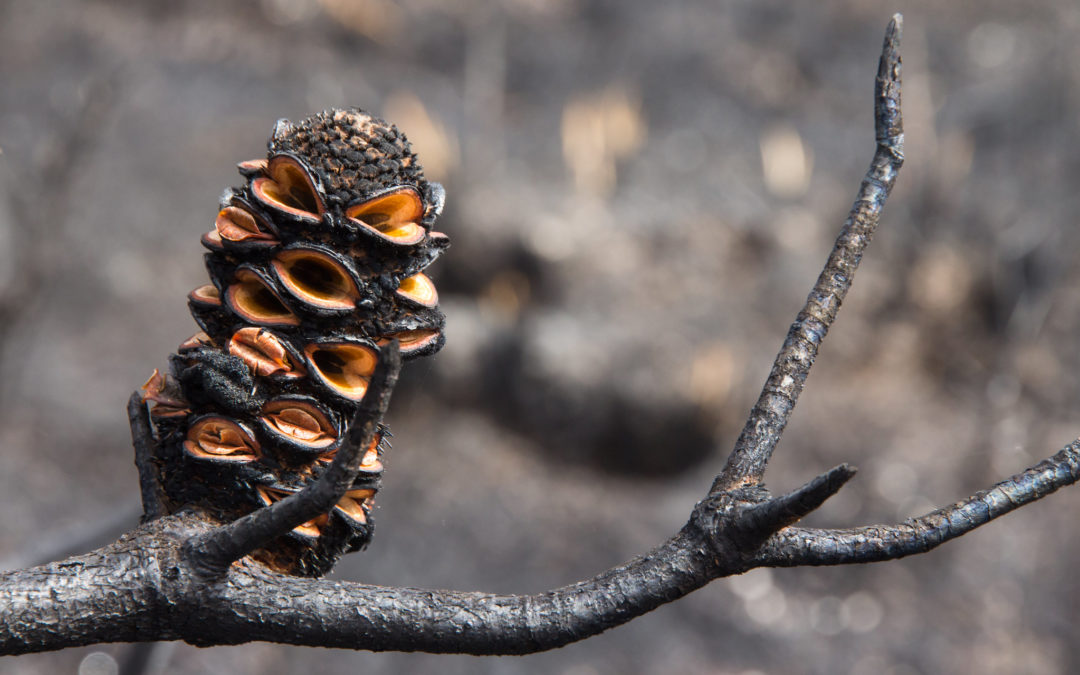A Banksia marginata cone opens to release seeds after being burnt by wildfire. Photo by Tim Rudman.
As November rolls on and fall descends in full in North America, nature is hardly beginning to tuck in for the long slumber of winter. In the Eastern United States, lands are battered with hurricanes, and in the West, wildfires rage on. The loss of life from these disasters is heartbreaking, and the impact on people’s lives can be truly gut wrenching. That devastation deserves our immediate attention. But, for the ecosystems affected by these disturbances, a different story can be seen.
These ecosystems are resilient. Their resilience can be measured as “the time it takes for an ecosystem to return to any stable state” or “how well a system can absorb a change and keep the same function and structure.” This resilience allows them to recover quickly. And, because they can recover so quickly and fully, these ecosystems can reap benefits from these disturbances. Pushing aside our rapidly changing climate due to unnatural and unbalanced activities provoked by humans, nature’s havocs are not actually always as destructive as we think they are. They can at times serve to revive and replenish nature.
Peaking in-between May and October, wildfires have been scorching the West Coast. These wildfires can arise from a spark or even just the heat of the sun. In 2019, the fires covered 259,823 acres of land. This year, astoundingly, the fires have already blazed more than eight million acres in a huge and powerful roar. As these wildfires burn lands to ash, they tear through countless ecosystems. Surprisingly, these fires actually aid the ecosystems they sweep through; and in this burning, nutrients are returned.
In forested areas, fire helps clean the forest floor by wiping out low-growing underbrush and debris. Without an excess of underbrush, room for new plants is created. When new plants begin to grow into this space, they provide shelter and food for forest life. The clearing of underbrush also increases the available water supply for other plants, helps refill any low or dry streams, exposes the forest floor to sunlight, and even helps to promote tree growth by reducing competition for the soil’s nutrients. Fire also aids in tree growth by killing diseases and insects that damage trees and by enriching the soil (fire-burned vegetation offers a rich array of crucial nutrients to the soil).
In addition to having a strong effect on plants and forest growth, fires also have a major impact on the organisms that occupy these forests. When faced with fire, forest life has three options: escape, thrive, or die. These organisms are usually able to escape or hide: “birds may fly away, mammals can run, and amphibians and other small creatures burrow into the ground, hide out in logs, or take cover under rocks. And other organisms, including large mammals like elk, will take refuge in streams and lakes.” Additionally, many insects flee the fires, crawling away in large groups. The fleeing of these forest animals benefits their ecosystem predators, who can easily spot and prey on these exposed animals.
There are also a fair amount of organisms which remain and thrive in a fire-filled environment. For example, the heat of the fires allows thermophilic fungi to produce spores and some plants to release seeds. This helps replenish the bottom of the ecosystem food chain, which benefits the entire ecosystem food chain.
We have a lot to learn from nature’s functions and adaptations in fire-prone environments. An Assistant Professor of Fire Science at UC-Merced, Dr. Crystal Kolden, looks to nature as she focuses on “wildfire in a coupled natural-human system”. She encourages us to “think about mimicking what these plants or animals have already evolved over time, in terms of how they exist in this environment of fire,” so that “we, as a human society… can learn to live successfully in these fire-prone systems”.
Similar to wildfires, when hurricanes hit the southern and eastern coasts every fall, they can bring with them positive changes in nature. Scientists at NSF CZO and UC Berkeley have found that after hurricanes disturb forests, there is often an increase in the amount of nutrients in the forest’s soil, which contributes to improved soil fertility. This soil fertility aids in post-disturbance regrowth.
Hurricanes can also benefit Southern ecosystems. For example, when Hurricane Harvey—a Category 4 hurricane—hit the coast of Texas in 2017, instead of fearing the wind and rain, Professor McKinney from Texas A&M saw Hurricane Harvey as “a reminder of the resiliency of nature.” The hurricane’s waters “offered a welcome and necessary flush of freshwater to bays and estuaries.” The hurricane’s rainfall freed sediment and nutrients that had been stuck in the ground and enabled them to rush into the estuaries. These sediments and nutrients compose the base level of the estuary food chain, so their increase helped replenish the base of the estuary ecosystem food chain. This replenished base was then able to feed other organisms up the food chain, resulting in a revived and refilled food web.
Natural disturbances like wildfires and hurricanes cause immense destruction and harm many communities. But sometimes in their destruction, they help mend the natural world. Scorched earth brings with it newly refreshed ecosystems which are ready to regrow and become even stronger. Intense floods and powerful rainwater bring with them a flush of replenishing nutrients and a flow of new growth. Just as rainbows follow rain, nature’s disturbances bring with them a newly cleansed Earth. As we mourn the loss of life and remember the pain caused by these disasters, we can look to the future and recognize the growth that can emerge from these challenging and unprecedented times.
 Faye Berry is a rising senior at Lower Merion High School in Pennsylvania. She has enjoyed nature from a young age and continues to explore the world around her.
Faye Berry is a rising senior at Lower Merion High School in Pennsylvania. She has enjoyed nature from a young age and continues to explore the world around her.

